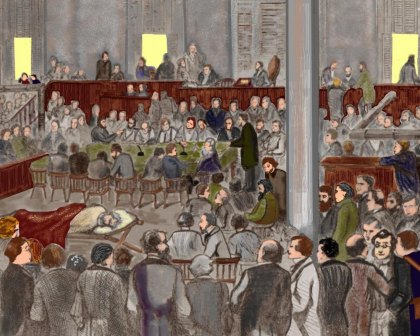John Brown's trial: The media circus is born

On Oct. 16, 1859, abolitionist John Brown led a raid on the arsenal at Harpers Ferry, then part of Virginia, now West Virginia. [Read the story here.] Wounded during the counterattack that resulted in his capture, Brown was nonetheless declared fit to stand trial in neighboring Charles Town. A stretcher was positioned in the courtroom for him.
The trial began the last week of October. Brown was convicted on Nov. 2, 1859, and sentenced to death by hanging for treason against Virginia, inciting slaves to rebellion and murder. This much-studied court case was an early example of what we would now call a viral story. Here are four reasons why:
-
It was a genuine media circus. “Brown’s was the first trial to be extensively reported, not just by state and local newspapers, but also by regional and national media,” wrote Brian McGinty in John Brown's Trial (Harvard University Press; 2009). “Reporters converged on the courthouse in Charles Town from all parts of the country, and news magazines with national circulation sent artists to record visual images of the trial."
-
Journalists made use of technology to get the story out. According to McGinty, "A special telegraph line was extended from Harpers Ferry to Charles Town for the specific purpose of covering the trial, connecting the proceedings there to national telegraph lines and allowing dispatches from the trial to be wired to editorial desks in eastern cities with a speed that would have been unimaginable a few years before.”
-
Brown was quotable. He proved that in his address to the court: “Now, if it is deemed necessary that I should forfeit my life for the furtherance of the ends of justice, and mingle my blood further with the blood of my children and with the blood of millions in this slave country whose rights are disregarded by wicked, cruel and unjust enactments -- I submit; so let it be done!”
- Luminaries kept the story going. On Oct. 30, 1859, before the trial was complete, Henry David Thoreau read his essay, "A Plea for Captain John Brown" to the citizens of Concord, Massachusetts. The essay gives a sense of how the public scarfed up news about Brown: "I read all the newspapers I could get within a week after this event," Thoreau wrote, "and I do not remember in them a single expression of sympathy for these men." In a speech one month later, Ralph Waldo Emerson praised Brown as someone who put his ideas into action.
Sources:
- Famous Trials, University of Missouri-Kansas City School of Law: John Brown's speech.
- John Brown's Trial by Brian McGinty (Harvard University Press; 2009).
- Google Books: Trials of the Century: An Encyclopedia of Popular Culture and the Law, Volume 1, By Scott Patrick Johnson (ABC-CLIO; 2010).
- Project Gutenberg: A Plea for Captain John Brown by Henry David Thoreau.
- The Morgan Library and Museum, New York: Ralph Waldo Emerson praises abolitionist John Brown.
Related:

